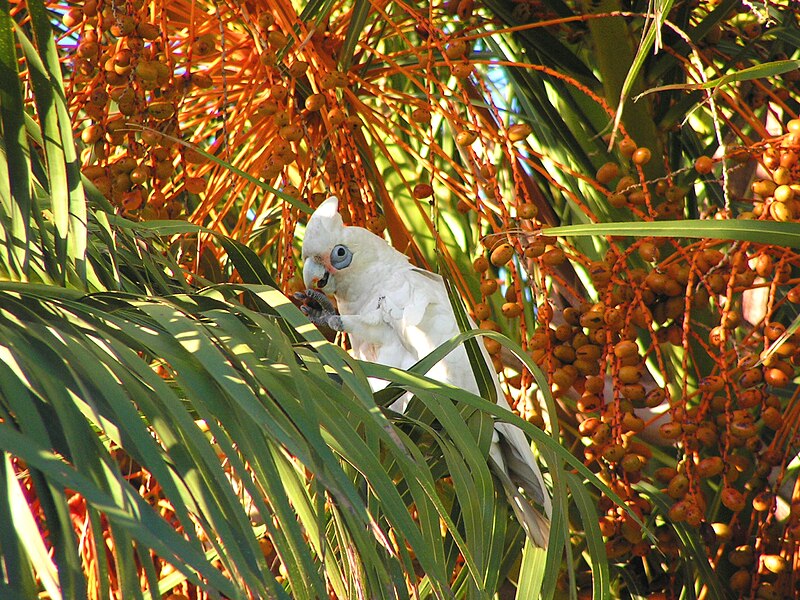 Cockatoos are often considered to be the most intelligent, playful and trainable of all parrots. But most new parrot-keepers believe that all cockatoos are large, noisy and very expensive, and tend to pass them by. While this applies to many of the world’s 40+ species, one group – the Corellas – averages only 12-15 inches in length; among the cockatoos, only the Cockatiel is smaller. Corellas possess all the wonderful traits of their larger relatives, and few of the drawbacks. In fact, the Goffin’s Cockatoo or Tanimbar Corella may just be the best cockatoo pet for most people.
Cockatoos are often considered to be the most intelligent, playful and trainable of all parrots. But most new parrot-keepers believe that all cockatoos are large, noisy and very expensive, and tend to pass them by. While this applies to many of the world’s 40+ species, one group – the Corellas – averages only 12-15 inches in length; among the cockatoos, only the Cockatiel is smaller. Corellas possess all the wonderful traits of their larger relatives, and few of the drawbacks. In fact, the Goffin’s Cockatoo or Tanimbar Corella may just be the best cockatoo pet for most people.
Corella Overview
Despite their small size, Corellas demand a great deal of attention and space, and cannot be relegated to life in a cage. Successful owners usually find that they become more like dogs than birds in their interactions with people. Well-habituated cockatoos of all kinds love physical play and touching, often to an amazing degree. They also tend to be unsurpassed when it comes to learning tricks.
The downside of all this is that they cannot tolerate boredom and solitude. Like other cockatoos, Corellas also have very strong personalities, and need a kind but firm owner if behavioral problems are to be avoided. Fortunately, Corellas tend to be quieter than larger species, and are not as quick to use their beaks to vent their frustrations (please write in for further information).
A large parrot or macaw cage can serve as home base for a Corella, but daily out-of-cage exercise and interaction time is absolutely essential. An outdoor aviary is also a wonderful option.
Goffin’s Cockatoo or Tanimbar Corella, Cacatua goffini
Goffin’s Cockatoos were common in the trade and very inexpensive when I first began working for bird importers in the 1970’s. This branded them as poor pets, but these little dynamos soon surprised everyone.
It turns out that there are few parrots that can match a well-trained Goffin’s. In my opinion, they pack all the brains and charm of an Umbrella Cockatoo into their 12.5 inch frame, and remain my choice for first-time cockatoo owners. Please see the article below for detailed information.
Little Corella or Bare-Eyed Cockatoo, Cacatua sanguinea
 This Australian native ranks right up there with the Goffin’s as a great choice for one seeking an easily-managed cockatoo. Owners invariably describe Little Corellas as “clownish”, rather quiet, and somewhat less demanding of attention than larger species (but they still must be treated as a pet, not a “cage bird”).
This Australian native ranks right up there with the Goffin’s as a great choice for one seeking an easily-managed cockatoo. Owners invariably describe Little Corellas as “clownish”, rather quiet, and somewhat less demanding of attention than larger species (but they still must be treated as a pet, not a “cage bird”).
Quite common in some parts of its range, the Little Corella sometimes raids crops and damages ornamental trees by stripping bark and branches. Feral populations inWestern Australiaare breeding with the Slender-Billed Corella (please see below), thereby threatening the future of their endangered relative.
Long-Billed Corella, Cacatua tenuirostris
This odd little cockatoo is full of surprises. It sports a long, slender, and most “un-parrot-like” bill that is employed to dig-up its “un-parrot-like” diet of roots, tubers and insects (it also consumes more typical parrot fare). The natural range is also unique, with the 2 known populations dwelling on opposite ends of the continent (Southeastern andSouthwestern Australia); each is now considered a distinct subspecies.
The Long-Billed Corella has a surprise in store for hobbyists as well. Cockatoos are not known for their vocabularies. While many can learn to mimic words, their “pronunciation” often renders them difficult to understand. Not so the Long-Billed Corella, however…its speaking abilities are widely considered to exceed those of all other Australian parrots.
Western Corella or Slender-Billed Cockatoo, Cacatua pastinator
 Formerly considered to be a subspecies of the Little Corella, with which it interbreeds (please see above), this species is now highly endangered and is not often seen in private or public collections in theUSA.
Formerly considered to be a subspecies of the Little Corella, with which it interbreeds (please see above), this species is now highly endangered and is not often seen in private or public collections in theUSA.
Further Reading
Video: Lola the Dancing Goffin’s (very good!)
Long-Billed Corella: notes from a breeder
Long-billed Corella image referenced from wikipedia and originally posted by Brett Donald
Western Corella image referenced from wikipedia and originally posted by D.Gordon E. Robertson
Corellas Feeding image referenced from wikipedia and originally posted by Snowmanradio
 That Bird Blog – Bird Care and History for Pet Birds
That Bird Blog – Bird Care and History for Pet Birds



